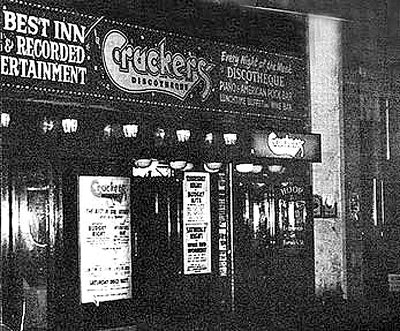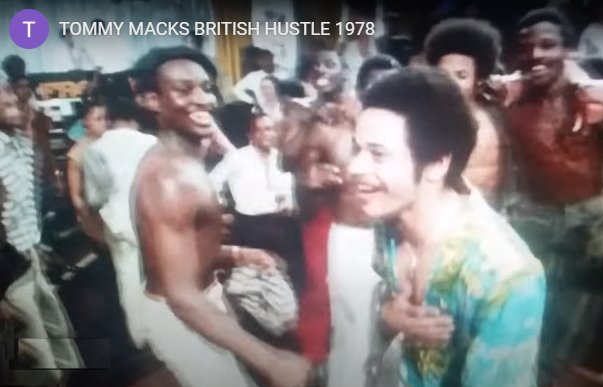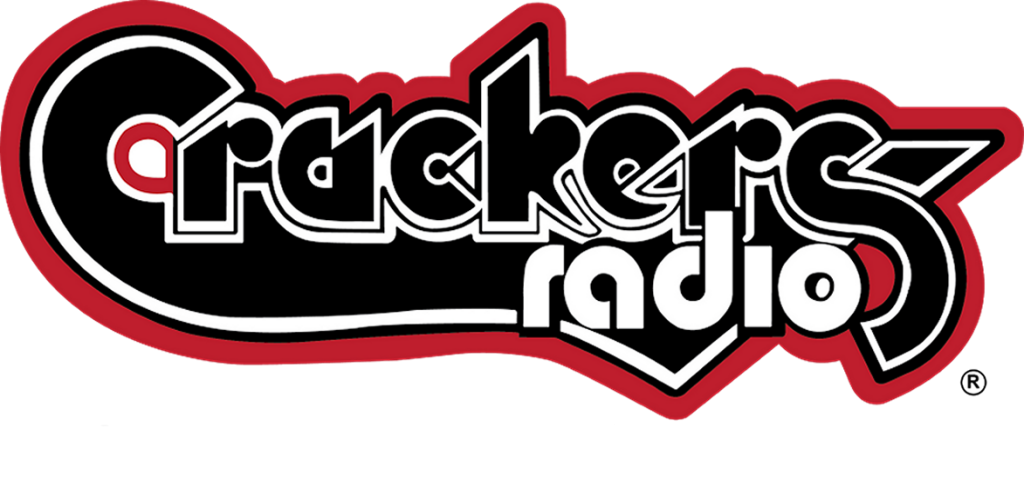The first stars of the UK dance music scene weren’t DJs or club runners.
They were the dancers.
Dance music authority Terry Farley pens a tribute to the forgotten legends of the late ’70s and early ’80s![]()
MARK ROMAN’S CRACKERS CLASSICS
The Crusaders – Stomp and Buck Dance
The Brecker Brothers – Sneakin’ Up Behind You
Fatback Band – Street Dance
Lyn Collins – Think
Crown Heights Affair – Dreamin’ a Dream
The first stars of the dance music scene weren’t DJs or club runners. They were the dancers. The theatrical urban ballet being played out at a series of small underground venues was, for many, the reason why this thing of ours was so exciting. And while small enclaves of young fashionable people dancing to imported US funk and disco was happening all over London and the south, one club captured the spirit of the dance battle, the spirit of the new fashions and the heat of the night.
The first time I actually got into Crackers was in 1975 on one of those cold rain-swept London nights. I distinctly remember a guy in his mid-30s (which was probably my dad’s age at the time) dressed as a Victorian-era French sailor. He sported wide-bottomed high-waisted French bags, small leather belt and a tight-hooped long sleeve T-shirt, all topped off with a beret. The man was flamboyantly dancing Hustle-style with a much younger lad to “El Bimbo” by Bimbo Jet, a rather kitsch French disco hit that evoked images of after-hours Pigalle in Paris. I had never met a gay man before, let alone watched two people of the same sex dance openly together in a club.
Another little firm of guys, in their early 20s, were dressed in 1940s-style demob suits and spats, bathing in the attention and adoration they were getting from the lesser souls in the club. We were told they were called Eric’s. At the time, I had no idea why, but we went off and rehashed the look for our next visit.
That night opened my eyes and mind to new styles, music and fashion, and I fell in love with the dingy basement club from that moment. It was, for many of today’s original acid house, rare groove and jazz DJs, THE birthplace of London club culture; a place where the possibilities of punk as a fashion were first explored and, for the first generation black British kids, a venue where they shook off the West Indian music of their parents and created something of their own.
Crackers was a melting pot of colours and sexuality, fashion and dance. In today’s design terms, it was a shithole disco basement that makes most of today’s cool Dalston and Peckham basements look plush, but it was the best club for dancers and underground music for at least six years – the benchmark we measured everything by.
Mark Roman was a 19 year-old soul fan living in Southend-On-Sea and playing in an East End pub when, in 1973, he was offered the chance to become a resident at Crackers. Earning the princely sum of £63 for a six-night week, Roman took the club in a black music direction, playing the whole night (at weekends that meant a seven hour set).
Roman started an import-only Tuesday night funk session aimed at the younger, more serious dancers who were being drawn to the club as word spread of his musical selection. Apart from the handful of “big people’s” black clubs such as Columbo’s and the Q Club in Paddington – as well as a smattering of illegal black clubs – most West End clubs that played black music still had a limit on how many blacks would be allowed in. After much harassment from Roman, the doormen at Crackers began to relax their colour and age rules.
In 1974, Roman also began a lunchtime soul session that would become legendary. Initially it was just Mark getting rid of the standard Friday lunchtime strippers’ session that were prevalent in the UK at the time and trying out the new music he had purchased. Word spread, and it was soon an essential part of the week’s clubbing. Dancers and record collectors alike would bunk off school and work to attend the session. From midday until 2:30 PM, one small part of the busy West End was buzzing, and the look on the shoppers’ faces as they saw the sweat-soaked clubbers wearing plastic sandals, Lee dungarees and rubber T-shirts pouring out of there was priceless.
At some point in 1976, however, there was a change. In the early days the average soul boy and girl went along to his local club or visited the West End mainly because of the music. By the summer of ’76, the power had shifted in the best clubs to the dancer. If you visited Crackers and the “royalty” were not out in force, the night seemed subdued, no matter how hard Mark Roman was playing.
Certain DJs, George Power in particular, would take advantage of this shift in power and work with the dancers, using them to break certain records and focusing upon them during the session. Make them feel special, and they would stay loyal. In our circle, a club was only as good as its dancers.
Unlike today, where the crowd face the DJ on a stage, the dancers faced each other and took very little notice of the DJ. We followed the best dancers who, apart from a handful, were all black. Fashion-wise, the majority of kids who pushed the envelope were white, and they too would follow the dancers. Add the right DJ to that mix, and you had a perfect club. My memories of many fantastic nights during that golden period of 1975-78 are not of what DJ played a certain record first, but who I saw dance to it and where.
LONDON BATTLE TUNES
Crown Heights Affair – Far Out
Celi Bee – One Love
Dexter Wansel – Life On Mars
Miroslav Vitous, a jazz guitarist from Prague who later helped form Weather Report, wrote an uptempo track that would become the ultimate London battle tune of the day. “New York City” was groundbreaking and innovative, merging Miroslav’s subtle jazz licks and Herbie Hancock’s hypnotic keys with a hard beating rhythm that pushed the dancers’ stamina to breaking point during its majestic nine minutes. “New York City” always takes me back to a Sunday night at Crackers during that long hot summer of 1976.
Miroslav Vitous – New York City
Tommy McDonald, an infamous character and perhaps London’s finest white soul dancer of the day, was dancing hard alongside four other main players in London’s intense dancers scene. A bare chested and heavily sweating Horace Carter, the acrobatic Clive Clarke, the elegant Wilbur and Jabba, a muscle-bound giant, were the last men standing during an intense Sunday night dancing competition. A rowdy wall of kids four or five deep surrounded them hollering and making Zulu style whoops in appreciation of every spin, drop or killer move.
Tommy was a right flash little git of London Irish stock with a bleach blonde number two crop with TOM written on the back in red. Tommy had studied jazz and tap at the Pineapple Dance Studio when he realised he needed to step up his game if he was going to compete for hallowed floor space with the best of the black lads. He was a master of spinning, doing a theatrical Broadway-style spot spin move that he made his own.
Although Tommy got straight in the face of anyone who challenged his role on the floor, he always did it with a smile, letting his opponent have a few short minutes of relative glory before launching into maybe half a dozen perfect spins and straight into fourth gear.
Most walked off while they could still laugh about it. The ones that stayed the course usually got humiliated. I never danced near the fucker, even though you knew that if you got into a groove and got your moves spot on he would slide across the floor to join you, slowly taking the pace up and up until you suddenly realised without knowing or wanting that you were involved in a burn-off you had no chance of winning.
Horace Carter was a fluid dancer. Shirtless and wearing skin-tight white jeans, he was pure poetry in motion. Everything he did looked easy and graceful yet so damn funky. I’m told by a certain female that he was regarded as a beautiful man by all the girls, with a torso to die for. Known by many of the dancers as the King of Crackers, he would later model for Vivienne Westwood.
Shane “Jabba” Henry was a law unto himself. Into martial arts training, he was a ’60s Hendrix head who was good mates with Norman Jay and respected throughout town. He also danced without a shirt (very much a Crackers thing for the very best dancers). Sweating profusely, the muscle-bound gentle giant with short dreadlocks would use his stamina as much as his undoubted style to burn opponents. Jabba’s enormous standing was also useful when it came to standing up to gangs of racist skinheads and Teddy Boys when the scene decamped to Margate for Bank Holiday showdowns. As the legend goes, he pulled some nunchucks from the boot of his car and led the charge into the boneheads from East London’s Last Resort and sent them in a panic back to the train station.
Wilbur was an elegant tall black lad from west London who was studying at the Rambert School of Ballet and Contemporary Dance and brought a fabulous balletic approach to the dancefloor. Wilbur was one of the Ealing boys who everyone thought was gay due to his moves, poise and flamboyant dress sense.
Clive Clarke was a small friendly black lad from Chiswick who worked as a gas fitter during the day and a dance floor destroyer at night. Clive danced in a more classical style with gymnastic moves thrown in, but he could also dance hard when the situation called for it and would often use comedy moves to see off challengers. Whereas Jabba would beat them down with a bat if necessary, Clive would do it with a smile… Either way, they lost very few dance-offs, that’s for sure. Clive would go on to be a professional choreographer and dance in many ’80s pop videos.
Back to that sweat-soaked and testosterone fuelled basement. The battle ended with the crowd shouting, hollering, pointing and waving in an ever-excitable manner for their favourite boogie boy (the usual boos and cat calls were missing, such was the regard held by the audience for the dancers on show that night). I’ve no memory who was deemed the winner or what was the actual prize, and as all the dancers were friends maybe it didn’t matter so much. But “New York City” was always the ultimate battle tune for me from that night on.
The new owner didn’t see Crackers as a refuge for London’s inner city dancers and the South East’s fashionistas. It was a tool to sell drinks.
In the autumn of 1976, just after that hot summer, Crackers got a new manager. One look at the diverse and fashionable crowd and the underground music they were dancing to made up this provincial newcomer’s mind: he wanted the playlist to go pop. Which, reading between the lines, probably also meant less blacks, less weirdoes and homosexuals and more of the type of people he had just left at his previous job in Swansea.
He didn’t see Crackers as a refuge for London’s inner city dancers and the South East’s fashionistas, but as a tool to sell drinks. Quite honestly, during the lunchtime session many just drank water straight from the cold tap in the grubby toilet or, at best, nursed a lemonade and blackcurrant for the whole session. Eventually the new manager turned off the cold tap in the men’s toilet to deny the dancers free hydration.
JAWS CLASSICS
Diana Ross – Love Hangover
Candi Staton – Young Hearts Run Free
Refusing to budge musically, Mark was moved to lower-profile club in the Wheatley chain, this time in Grove Green Road, Leytonstone called Jaws. The Crackers crowd loved Roman and followed him there. If anything, it was even more intense than Crackers. Smaller and a damn sight hotter, holding barely 250 people, it was one-in, one-out almost from opening time. Although punk’s explosion in that summer was starting to attract the trendier white soul boys, Mark’s night at Jaws still had a great mix of black and white kids wearing cutting-edge fashion and busting the latest moves.
After six steaming months, the funk night there would also be sadly closed down, this time due to neighbours complaining to the Old Bill because of the noise and nuisance. The club owners told Roman it was “too busy.” The influx of large groups of black lads who were not from the manor didn’t help either, as well as scores of rowdy lads jumping the gates at the Central Line station to bunk the last tube home. Mark would leave the UK to work and live in Germany, leaving a huge gap in the inner London scene and, at Crackers in particular, one that needed big shoes and a bigger ego to fill.
George Power was a Greek-born North Londoner who had started out as a mobile disco DJ doing weddings and pubs and even Radio 1 roadshows warming up for Fluff Freeman and Jimmy Savile. As the early ’70s fever for soul and funk grew, he took up residencies around his North London manor, Sundays at the Tottenham Royal.11A huge ballroom that had been THE skinhead Saturday night out in the late ’60s and had been the scene of many a football battle, usually involving gangs from Spurs and Arsenal. There must have been something about the place, because George’s successful Sunday night soul and reggae residency ended when the soul and reggae factions decided they hated each other’s music so much that regular fights would break out. The Royalty in Southgate, a North London suburb, was his next step, but in George’s words “I attracted too many black people.”
Meanwhile Crackers was enjoying success with the punk themed Vortex nights, but the numbers for funk and soul nights were in decline. They tried many DJs with different degrees of success, but none came up to the level of Roman until Power took over Sundays, the specialist night for the dancers, and the already popular Friday lunchtime session. Under Mark Roman, the pre-punk Crackers had been a real mix of races, genders, cutting-edge fashion and street funk and yet still remained a (somewhat) guarded secret. By the time Power got behind the decks there, punk had taken a fair old chunk of the really cool white kids and there was a new generation of younger, mainly black dancers ready to battle the older legends who had made the club their own.
GEORGE POWER CRACKERS CLASSICS
Pleasure – Joyous
Saturday Night Band – Come On…
Doug Richardson – Salsa Mama
Norman Connors – Captain Connors
Eastside Connection – You’re So Right For Me
During the summer of 1976, the whole soul scene exploded in London and the south. You would see kids from your area who had taken the piss out of your clothes a couple of years back all dressed up in their new carpenter jeans and freshly-cut wedge barnet. No more snide remarks about you being a poof or laughing at boys daring to dance. It seemed every kid wanted in. Crackers became more street, more edgy, more about the dancing and the burns rather than the posturing and preening that had accompanied the fabulous dancing during those early Mark Roman days.
This battling and burning would take a logical progression later on in the decade and into the ’80s, eventually morphing into an urban jazz scene (the upstairs room at the George Power-promoted Electric Ballroom in the early ’80s being the most extreme example). The dancers held total control by then. The DJ and the rest of the club were of little consequence as long as the right battle tunes were being played. These dancers were the younger siblings of the original Crackers prancers and dancers, some as young as 14 or 15 years old, their skinny bodies and loose limbs taking the original soul and jazz funk moves and floor ethics and stepping up the game to heights not seen before (or sadly since).
The white-boys-stay-on-the-carpet rule was enforced quite strictly by the resident dancers who owned the wooden floor area, with only a handful of very good white boys having the skill and the chutzpah to put it on the line. The carpet at Crackers was rotten and sticky with all the spilt lager and fag butts from the straight-goers’ nights and, on some occasions, it was like dancing in sand. On quieter nights you could find a space on the edges of that hallowed wooden floor, do you own thing and be left alone. But most nights it was better to watch and learn. I wore out a hole in my bedroom carpet in a vain attempt to emulate the moves of Horace, Pinky, Trevor Shakes and co.
It’s also worth noting that Crackers was about 80% boys. The girls who did attend and dance, however, were on point in every way. Crackers Girls may have been few in numbers, but the girls could dance. And those that didn’t? They made up for it in the style stakes, with Fiorucci, Joseph and Kenzo among the key designers.
Fashion-wise for the boys, Crackers became more sportswear-oriented than the high-end fashion and pre-punk look that had made the club so trendy five years or so earlier. Now it was a mass of Kickers, Pods, Ball and FU’s jeans, Kangol hats, deerstalkers, Lois jumbo cords, Green Flash sneakers, Adidas T-shirts, Lonsdale sweatshirts and boxing boots. These new kids in their mid- to late teens formed the core of a crowd that would push George into an even more jazzy selection and follow him to the legendary Horseshoe nights.
This all would truly come of age at The Electric Ballroom in the run-down but hip district of Camden, where George Power would play electro downstairs in the large ballroom, while upstairs in an insanely hot and small room DJs Paul Murphy and (later) Gilles Peterson would play hard uncompromising jazz to a group of fiercely loyal black dancers. The culture of “the dancer” lasted right through the ’80s up until the house explosion, when kids started dancing with their arms and hands, not their hips and feet, reacting to euphoric moments in the music in a mass movement of communal spirit. Dancing was now for everyone, not just the chosen few.
As time has gone on, the crowd started dancing towards the DJ booth and the actual dancing itself became less and less energetic. We’ve now ended up, in many cases, with clubbing becoming almost a spectator sport. There are always exceptions. New York’s Lofting, or House Dancing, has became popular around the more mature house scenes especially in America and Japan, while in London new kids from the outer London boroughs and leafy suburbs have the Shuffle (an easier version of the 1960s Rude Boy battle dance). But these days, in my opinion, far too much emphasis is put upon what is happening in the booth and not on the dancefloor itself. As Frankie Knuckles once said, “The heart of the party is in the middle of the dancefloor.”






